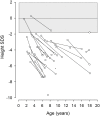Low renal but high extrarenal phenotype variability in Schimke immuno-osseous dysplasia
- PMID: 28796785
- PMCID: PMC5552097
- DOI: 10.1371/journal.pone.0180926
Low renal but high extrarenal phenotype variability in Schimke immuno-osseous dysplasia
Abstract
Schimke immuno-osseous dysplasia (SIOD) is a rare multisystem disorder with early mortality and steroid-resistant nephrotic syndrome (SRNS) progressing to end-stage kidney disease. We hypothesized that next-generation gene panel sequencing may unsurface oligosymptomatic cases of SIOD with potentially milder disease courses. We analyzed the renal and extrarenal phenotypic spectrum and genotype-phenotype associations in 34 patients from 28 families, the largest SMARCAL1-associated nephropathy cohort to date. In 11 patients the diagnosis was made unsuspectedly through SRNS gene panel testing. Renal disease first manifested at median age 4.5 yrs, with focal segmental glmerulosclerosis or minimal change nephropathy on biopsy and rapid progression to end-stage kidney disease (ESKD) at median age 8.7 yrs. Whereas patients diagnosed by phenotype more frequently developed severe extrarenal complications (cerebral ischemic events, septicemia) and were more likely to die before age 10 years than patients identified by SRNS-gene panel screening (88 vs. 40%), the subgroups did not differ with respect to age at proteinuria onset and progression to ESKD. Also, 10 of 11 children diagnosed unsuspectedly by Next Generation Sequencing were small at diagnosis and all showed progressive growth failure. Severe phenotypes were usually associated with biallelic truncating mutations and milder phenotypes with biallelic missense mutations. However, no genotype-phenotype correlation was observed for the renal disease course. In conclusion, while short stature is a reliable clue to SIOD in children with SRNS, other systemic features are highly variable. Our findings support routine SMARCAL1 testing also in non-syndromic SRNS.
Conflict of interest statement
Figures




References
-
- Morimoto M, Lewis DB, Lucke T, Boerkoel CF: Schimke Immunoosseous Dysplasia In: Pagon RA, Adam MP, Ardinger HH, et al., editors. GeneReviews® [Internet]. Seattle (WA): University of Washington, Seattle; 1993–2016. http://www.ncbi.nlm.nih.gov/books/NBK1376/ - PubMed
-
- Boerkoel CF, Takashima H, John J, Yan J, Stankiewicz P, Rosenbarker L, et al. Mutant chromatin remodeling protein SMARCAL1 causes Schimke immuno-osseous dysplasia. Nature Genet. 2002; 30:215–220 doi: 10.1038/ng821 - DOI - PubMed
-
- Bhat KP, Betous R, Cortez D. High-affinity DNA-binding domains of replication protein A (RPA) direct SMARCAL1-dependent replication fork remodeling.J Biol Chem 2015; 290:4110–7 doi: 10.1074/jbc.M114.627083 - DOI - PMC - PubMed
-
- Trautmann A, Bodria M, Ozaltin F, Gheisari A, Melk A, Azocar M et al. Spectrum of Steroid Resistant and Congenital Nephrotic Syndrome in Children: The PodoNet Registry Cohort. Clin J Am Soc Nephrol. 2015; 10:592–600 doi: 10.2215/CJN.06260614 - DOI - PMC - PubMed
-
- Kiefer F, Arnold K, Künzli M, Bordoli L, Schwede T. The SWISS-MODEL Repository and associated resources. Nucleic Acids Res 37:D387–D392, 2009. doi: 10.1093/nar/gkn750 - DOI - PMC - PubMed
MeSH terms
Substances
Supplementary concepts
LinkOut - more resources
Full Text Sources
Other Literature Sources
Medical

